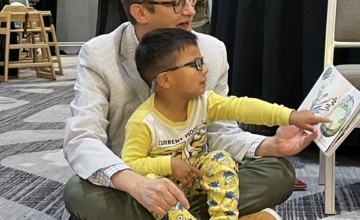Being able to talk about how a person’s cultural context influences the way she approaches her work is an important way that program leaders can provide support to staff members.
Professionals can use the process of cultural reciprocity to examine cultural differences, establish a shared understanding, and build a stronger working relationship with families. Cultural reciprocity is a four-step process initiated by the provider that requires awareness, communication, and negotiation of culturally based beliefs, values, and assumptions, and which assists professionals to address culturally based differences and identify mutually agreeable solutions. It is a two-way information-sharing process, meaning that families and professionals each share information about themselves, their cultures, and their beliefs to develop a common understanding of the problem (Kalyanpur and Harry, 1999). This process of give and take, both parties listening and learning from the other, helps parents and providers to move beyond their differences and focus instead on understanding and compromise.
The values underlying the process of cultural reciprocity are mutual respect, collaboration, and reciprocity. Mutual respect refers to the acknowledgment that both parents and providers contribute an equally valued perspective to the dialogue. Collaboration describes the emphasis placed on partnership and the sharing of decision-making power that is inherent in this model. Reciprocity refers to the need for understanding, compromise, and open-mindedness that is integral to resolving any challenges that may arise.
Just because an issue hasn’t come up doesn’t mean that it’s not there.
Because the process of cultural reciprocity addresses each family situation as unique, it avoids the trap of developing solutions based on stereotypes. Instead of offering providers a “recipe” of how to work with a specific “type” of family, it provides infant-family professionals with a conceptual framework to examine cross-cultural communication on a case-by-case basis.
Many infant-family programs not only serve a diverse group of families but also have a very diverse staff themselves. The issues of culture, communication style, parental goals, activity settings, and dealing with differences discussed in this publication are equally applicable to families as to infant-family program teams. Because this is a complex topic, we cannot do it justice in this publication. However, below are three critical issues for program leaders to consider as they work to create a program culture that is open, inclusive, and supportive of all staff.
- Program leaders must individualize their approach based on each staff member’s culture, temperament, and personal history. Just as staff members are asked to provide individualized services to families, program leaders, too, must get to know each staff member and establish a unique relationship with each individual. This effort helps to create the kind of mutual, respectful, and collaborative relationships that characterize a culturally sensitive work environment.
- It is important to discuss differences. Just because an issue hasn’t come up doesn’t mean that it’s not there. For example, a staff member may feel hurt and marginalized because colleagues (good-naturedly, they think) tease her about the food she brings for lunch. Or a staff member may be frustrated by the fact that the center’s “welcome back” sign is only in English, not Spanish. Another may be upset that she needs to use vacation time to observe the Jewish high holidays.
Being able to talk about how a person’s cultural context influences the way she approaches her work is an important way that program leaders can provide support to staff members. One way to help this happen is to ensure that staff members have access to a safe place—and a safe relationship—within which they can discuss these sometimes uncomfortable, sometimes difficult issues. Reflective supervision is one strategy program leaders can use to create opportunities for discussions of this nature to develop.
- Cultural reciprocity strategies can be used with colleagues as well as with families. At times, conflicts occur with colleagues. Sometimes these are, at their root, caused by differences in cultural beliefs, values, and expectations. Using the four steps of cultural reciprocity honors each person’s beliefs and experiences and gives each person an equal responsibility for finding a solution.
References
Kalyanpur, M., & Harry, B. (1999). Culture in special education: Building reciprocal family-professional relationships. Baltimore: Paul H. Brookes Publishing Co.




